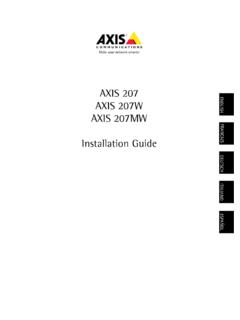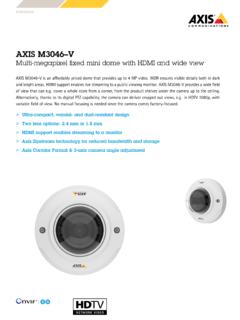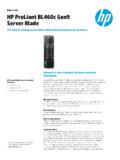Transcription of Large surveillance systems - Axis Communications
1 Large surveillance systemsSystem Overview DocumentWhitepaperTable of contents Overview 3 1. Purpose and motivation 3 2. Overview of the networks 4 Outdoor network 4 The Core 4 The Outdoor Stations 6 Milestone VMS 6 Indoor network 7 The Control Center 7 The Core 7 The floors 9 Allied Telesis switch network configuration 9 Genetec VMS 10 3. Further reading 10 Appendix I 11 Appendix II 143 OverviewDuring May 27-31, 2013, axis Communications AB hosted a global technical conference with participation and cooperation from partners including ABB, Allied Telesis, Firetide, Genetec, HP, NetApp, Microsemi, Milestone, Moodifier, Raytec, Veracity, and Weidmuller.
2 The conference theme was Large surveillance Installations. Two separate and fully operational Video surveillance systems (VSS), deploying different technologies, was set up and tested; one indoor network and one outdoor network, each with 1000 cameras. It is important to know that the naming of the 2 systems depends only on the cameras. In the outdoor system both indoor and outdoor axis cameras were used, whereas in the indoor system only indoor cameras were used. The other components in the VSS works well with both indoor and outdoor paper describes the purpose and goal of the conference and provides an overview of the two video surveillance systems .
3 More detailed papers on the configuration and setup of each system will also be made and motivationVideo surveillance has moved to the forefront globally to serve the security needs within military, govern-ment, utilities, corporate, medical, retail, hospitality, transportation, education, and more. Today, Large IP Video surveillance systems (VSS) consisting of over 1000 cameras are becoming more common. In a Large campus network, or Metro-Area Network (MAN), the IP video surveillance system is typically overlaid on an infrastructure that has been designed to carry multiple applications and services.
4 Such a network, supporting a significant number of end users, needs to be very reliable, manageable, and scalable. The demand from users of a system that delivers high-resolution, high-definition, real-time results also put higher requirements on a reliable high-speed IP network infrastructure. To ensure this, network equip-ment, cameras, the server /data center, the monitoring center, as well as the Video Management systems (VMS) all must be working together effectively in harmony. This presents great challenges for the system integrators and engineers.
5 There is no one solution that fits all. During the Global Technical Conference, a state-of-the-art, Large scale digital video surveillance system with 1000 cameras was deployed. The purpose of the deployment was to highlight the critical components of this kind of system through testing and troubleshooting to identify bottlenecks, limitations for network design, configuration, reliability and objective was to clearly identify building blocks that can be easily copied in order to design a highly reliable, manageable, as well as scalable system .
6 During the conference, tests to identify the mini-mum memory and storage configuration to support such Large networks were conducted. As two separate technical solutions were set up, we had the ability to compare the performance of blade versus Rack servers. We also tested how to make better use of the servers by adding on Hypervisors to increasing the number of VMS recording servers per physical server . These findings are presented in two seperate white papers. Please refer to Large survaillance systems - An Allied Telesis, axis , Genetec and NetApp goint solution guide and Large survaillance systems - An axis , HP and Milestone solution guide for more details.
7 The system integrators and engineers will be able to refer to these papers as solution guidelines. The stakeholders of the event were experts of leading companies within the following fields: IP cameras, network switching, computer servers, fiber interfaces, VMS providers, wireless manufacturers, structured cabling and network of the networksDuring the conference, two completely separate networks supporting two VSS was configured and tested with different technologies. The two VSS setups varied in both hardware and software.
8 One network was installed for outdoor - and the other one for indoor environment. Each network consisted of 1000 cam-eras. It was not physically possible to test with 1000 cameras during the one week conference period. To build the 1000 camera solution a combination of real- and simulated cameras were used. axis Virtual Camera (AVC), a software application that generates multiple virtual cameras streams from an actual physical camera was used to replicate. About 50 to 70 physical cameras were installed in each network; the rest were virtual cameras generated to simulate the actual data traffic and bandwidth requirement for such a Large NetworkThe network was divided in different outdoor stations connected via fiber, wireless and copper.
9 The core of the network was located in a customized 40ft shipping container. The container contained servers, storage, core switch, power supply, workstation, video screens, cameras, lighting, cooling and heating system , all the necessary equipment to support the 1000 camera network. The network had 52 phys-ical cameras installed. Of these, 22 of them were installed inside the container and 30 were distributed among the four outside stations. Please see the diagram in Appendix II for details.
10 The rest of the cam-eras were simulated through axis Virtual Cameras (AVC). The CoreThe core of the network consisted of two racks with the equipment illustrated in Figure 1 Figure 1. The core of the network consisted of two racks with the HP BL460c Gen8 E5-2660 2P 96GB blade servers2. HP BLc7000 blade enclosure, the enclosure supports up to 16 blade servers. At the conference, seven HP BL460c Gen8 E5-2660 2P 96GB blade servers was mounted in the blade enclosure. On each server , Hypervisor from Microsoft HyperV was used to manage the virtual ma chines.
















